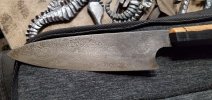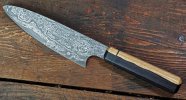- Joined
- Sep 22, 2019
- Messages
- 9
When I’m etching my steel it always seems to turn out great with very little contrast.thoughts?
my process:
Harden
Temper
Hand sand to 2000 grit
let it sit in FC for 5-15 min( ferric is premixed in a solution) I’m not diluting it or mixing.
remove and rinse with water and its gray with very little contrast.
I’m re-using the FC every time i etch a new blade. Returning it back to the bottle. could this be an issue?
Am I missing something that’s causing it to turn gray?
The Damascus is Alabama Damascus.
my process:
Harden
Temper
Hand sand to 2000 grit
let it sit in FC for 5-15 min( ferric is premixed in a solution) I’m not diluting it or mixing.
remove and rinse with water and its gray with very little contrast.
I’m re-using the FC every time i etch a new blade. Returning it back to the bottle. could this be an issue?
Am I missing something that’s causing it to turn gray?
The Damascus is Alabama Damascus.


